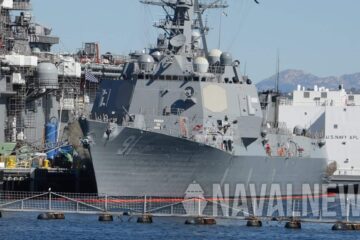By Lockheed Martin
“LCS is the second largest ship class in the U.S. Navy, and Lockheed Martin is proud to deliver capability and added force projection with each additional hull,” said Joe DePietro, Lockheed Martin vice president and general manager of Small Combatants and Ship Systems.
“LCS is ready to serve a variety of missions, and our team is working with the Navy to add lethality and survivability enhancements to meet the missions sailors will face in the future.”
Unique among combat ships, LCS is designed to complete close-to-shore missions and is a growing and relevant part of the Navy’s fleet.
- It is flexible—with 40 percent of the hull easily reconfigurable, LCS can be modified to integrate capabilities including over-the-horizon missiles, advanced electronic warfare systems and decoys, and in the future, vertical launching systems or laser weapon systems.
- It is fast—capable of speeds in excess of 40 knots.
- It is automated—with the most efficient staffing of any combat ship.
- It is lethal—standard equipped with Rolling Airframe Missiles (RAM) and a Mark 110 gun, capable of firing 220 rounds per minute.
“Littoral combat ships are designed to operate in more areas than a typical Navy ship, including shallow water near the coastline,” said the ship’s sponsor and Northfield, Minnesota native Deputy Undersecretary of the Navy Jodi Greene. “Consequently, LCS 21 is going to bring the name ‘Minneapolis-Saint Paul’ all around the globe.”
Lockheed Martin is in full-rate production and has delivered eight ships to the U.S. Navy. There are eight ships in various stages of production and test. This year, Lockheed Martin and Fincantieri Marinette Marine will begin construction on two ships, deliver two ships, complete sea trials for two ships and see three ships commissioned (LCS 13, 15 and 17).
“We take great pride in building the future USS Minneapolis-Saint Paul and all of the Freedom variant ships,” said Jan Allman, Fincantieri Marinette Marine president and CEO. “LCS 21 and her sister ships will soon represent the interests of the United States where and when needed.”






